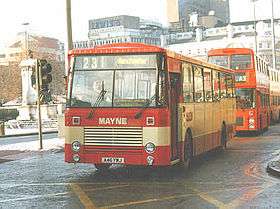Dennis Falcon
The Dennis Falcon was a rear-engined single-decker bus, double-decker bus and coach chassis manufactured by Dennis between 1981 and 1993. It was mostly built as a single-decker bus, although some express coaches and a small number of double-decker buses were also produced. The total number built was 139, plus one development chassis.[1]
| Dennis Falcon | |
|---|---|
 Mayne Coaches Marshall bodied Dennis Falcon | |
| Overview | |
| Manufacturer | Dennis |
| Production | 1981–1993 |
| Assembly | Guildford, England |
| Body and chassis | |
| Doors | 1 or 2 |
| Floor type | Step entrance |
| Powertrain | |
| Engine | Gardner 6HLXB Gardner 6HLXCT Perkins Daimler-Benz |
| Transmission | Voith DIWA851 |
| Dimensions | |
| Length | 9.0m to 12.0m |
| Width | 2.5m |
| Height | 3.0m or 4.4m |
| Chronology | |
| Successor | Dennis Lance |
Design
The Falcon was closely derived from the Dennis Dominator, the front half of the chassis being identical. The original horizontal-engined Falcon H had a layout recalling that of the Bristol RE with the longitudinally-mounted Gardner engine driving forward above the Dennis-built portal rear axle to a Voith gearbox and reversing unit which then took drive rearward into the driving-head of the axle.[2][3] The later Falcon HC had a more orthodox continuous driveline, resembling that of the Seddon Pennine RU, the C (for continuous drive) denoted the Voith transmission close-coupled to the Gardner engine with a short propeller shaft taking drive into a straight Kirkstall spiral-bevel double-reduction rear axle. For these types the frame was raised aft of the rear axle to provide clearance for the underslung engine.
The Falcon V, with Daimler-Benz V6 engines in the double-decker buses and Perkins V8 engines in the coaches, was even closer in frame-concept to the Dominator.[4]
Single decker buses
Single-decker buses were based on the Falcon H and HC chassis. Six English municipal operators bought Dennis Falcon single-decker buses between 1981 and 1993:
| Operator | Bodywork | Number of Vehicles | Years |
|---|---|---|---|
| Ipswich Buses[5] | East Lancs (18), Northern Counties (7) | 25 | 1983-1989 |
| Leicester Citybus | Duple (7), East Lancs (9), Northern Counties (7) | 23 | 1981-1993 |
| Hartlepool[6] | Wadham Stringer (6), Northern Counties (6) | 12 | 1983-1985 |
| Chesterfield Transport | East Lancs (4), Marshall (5) | 9 | 1983-1984 |
| Grimsby-Cleethorpes | Wadham Stringer | 4 | 1983 |
| Hyndburn | East Lancs | 2 | 1984-1985 |
Leicester bought the first Falcon in 1981, with Duple Dominant Bus bodywork, and added six more between 1983-1984. Despite selling these to Thamesdown Transport in 1987, Leicester later purchased sixteen more Falcons between 1991-1993, including the last Falcon built.
Hartlepool Borough Transport bought twelve dual door examples. Six with Wadham Stringer bodies in 1983 and the other six with Northern Counties bodies in 1985. They remained operational into the days of Stagecoach Hartlepool buses.
National Bus Company subsidiary Alder Valley added one Dennis Falcon HC to its fleet in 1983, with Wadham Stringer bodywork of semi-coach specification.
In 1990 and 1993, three British Bus subsidiaries purchased Falcon single-decker buses:
| Company | Bodywork | Number of Vehicles | Years |
|---|---|---|---|
| London & Country | East Lancs | 10 | 1990 |
| North Western[7] | East Lancs | 8 | 1990 |
| Midland Red North | East Lancs | 9 | 1992-1993 |
Coaches
.jpg)
In 1982, the National Bus Company bought 10 express coaches with Duple Goldiner IV bodywork to National Express Rapide specification. These were based on the Falcon V chassis.[8] They were split between Western National (5), Yorkshire Traction (2), National Travel (West) (2) and West Yorkshire RCC (1). But they proved unreliable and did not last very long in National Express service.
Kowloon Motor Bus purchased 20 Duple Metsec bodied coaches based on the Falcon HC chassis in 1985/86 for airport express services in Hong Kong.[9][10] The last was withdrawn in 2001.
Double-deckers
Only six Falcon V double-decker buses were built. The first was used as a demonstrator. Two examples with East Lancs bodywork went to Nottingham City Transport in 1982 as part of their evaluation of the various new generation double-decker buses then available. High noise levels were one criticism made against them. The final three, with Northern Counties bodywork, went to Greater Manchester Transport in 1984.
Successor
The Falcon was replaced by the Dennis Lance.
References
- Dennis Falcon Bus Fleet Lists on the Web
- Falcon swoops Commercial Motor 27 September 1980
- Morris, Stephen (1981). "Dennis in 1981". Buses Magazine. Shepperton: Ian Allan Publishing (317): 348/9.
- Morris, Stephen (2005). Booth, Gavin (ed.). "Dominating No More". Buses Focus. Hersham: Ian Allan Publishing (35): 40–45.
- Falcons replace Swifts Commercial Motor 1 August 1981
- Upstage HD Commercial Motor 29 September 1984
- Falcons fly off to NWRC Commercial Motor 14 June 1990
- NBC Falcons Commercial Motor 30 January 1982
- Dennis order Commercial Motor 19 January 1985
- "Hong Kong Buses Part 3: Kowloon Motor Bus" Fleetline issue 249 July 1997 page 116
External links

- Flickr gallery